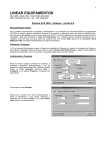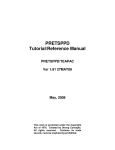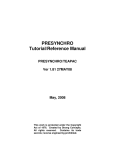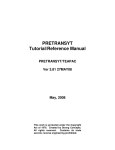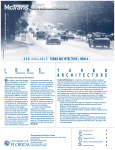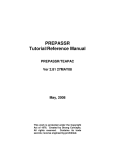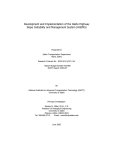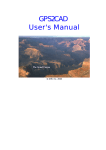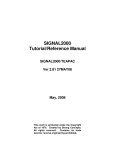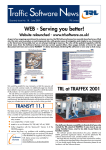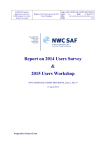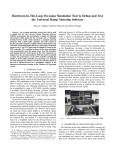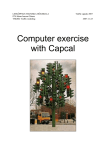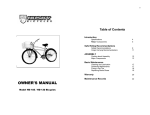Download 01-Winter - University of Florida
Transcript
™ Moving Technology Volume 24 Winter 2001 Newsletter THE BRIDGE SOFTWARE INSTITUTE INTRODUCES FB-PIER Photo courtesy Florida Dept. of Transportation MORE ON TRANSYT-7F™ CONTROLLER INTERFACE DEVICE HELPS IMPROVE TRAFFIC SIGNAL TIMING P. 2 Release 9.3 was the first in a series of revisions designed to make TRANSYT-7F user-friendly. The new TRANSYT-7F input data editor introduced within release 9.3 is intended to provide users with a more efficient and intuitive mechanism for coding input data. Until now, the featured input data editor for TRANSYT-7F has been McT7F, which is designed to display and edit “record types”. The traditional record type format, which can be seen within most TRANSYT7F input (*.TIN) data files, is not well understood by some users. TRANSYT-7F input data can now be coded directly into software screens designed to mimic the popular Highway Capacity Software (HCS) input data screens. Since TRANSYT-7F can model complex intersections, a simple keypress loads input data for additional traffic movements into the same screen, 12 at a time. Other input data screen features include: • Link numbers automatically listed on each screen • Context-sensitive F1 help for each field • Field disabling for non-existent movements • Automatic balancing of the linkto-link traffic flows • Automated coding of link lengths* • Intersection names on each screen* • User-defined behavior of the Enter key (save data, or move to next field)* * -- available in release 9.4 In addition to the new input data screens, TRANSYT-7F input and McTrans Department of Civil and Coastal Engineering PO Box 116585 Gainesville FL 32611-6585 (352) 392-0378 Toll Free 1-800-226-1013 Fax (352) 392-6629 Email [email protected] http://mctrans.ce.ufl.edu/ UNIVERSITY OF FLORIDA McByte continues p. 3 New Products 4 Updated Products 6 Did you know? 7 Advertising Directory 8 Products Listing 22 Conference & Training Calendar 32 McTrans Winter 2001 2 CONTROLLER INTERFACE DEVICE New Hardware and Software Product Helps Improve Traffic Signal Timing By Michael Kyte Director, National Institute for Advanced Transportation Technology (NIATT) Many complex factors are involved in designing a good traffic signal timing plan, such as traffic demand, street geometry, and spacing between traffic signals. Once a traffic engineer has designed a good signal timing plan, the plan should be tested and finetuned using an actual traffic controller before it is implemented in the field. Traffic simulation programs such as FHWA’s CORSIM allow engineers to test a signal timing plan, but CORSIM’s controller logic is “generic” and does not incorporate all of the features that are available on today’s advanced traffic controllers. NIATT’s Controller Interface Device (CID) bridges this gap. The CID provides a real-time link between the CORSIM traffic simulation model and a NEMA or 170 traffic controller, in what is called real-time hardware-in-the- 1-NIATT’s Controller Interface Device 2-CID’s Intersection Data Screen, where user enters movements, phases and CID ID number. loop simulation. In this type of simulation, the traffic controller component of the simulation_the internal controller emulation logic_is replaced by a real traffic signal controller. Both the model and the controller run in real time, i.e. one second of simulation takes one second of actual time. When an engineer wants to test a timing plan with hardware-in-theloop simulation, the following events occur: 1. CORSIM generates detector actuations by modeling simulated vehicles crossing simulated detectors. 2. The simulated detector actuations are sent to the actual controller hardware. 3. The controller reacts to them as it would react to real detector actuations, by updating phase indications according to the phasing and timing plan programmed into the controller. 4. The phase indications are subsequently read back from the controller hardware to CORSIM, and assigned to the simulated traffic signals. 5. The simulated vehicles then react to the simulated traffic signals by stopping or departing as appropriate. It is the CID that makes this real-time exchange of data possible. The CID also allows the engineer to fine-tune the timing plan in the office rather than out in the field, since field-testing is a timeconsuming process that can potentially cause severe traffic disruptions. Suitcase Tester Function In addition, the CID can be used as a “suitcase tester,” to test and evaluate the operation of a traffic controller before it is installed in the field. A traditional suitcase tester is a suitcase-like box containing switches that, when linked to a traffic controller, can activate functions on the controller and monitor outputs from the controller. A standard suitcase tester does offer a controlled environment for testing a controller, but it is a time-consuming and inefficient process. The CID’s suitcase tester function provides a more convenient way to test the most widely used functions of NEMA or 170 traffic controllers. Government, Education, Industry Collaboration The CID is the result of a unique and highly successful collaboration between government, education, and private industry. In the mid90’s, FHWA developed a prototype CID, which worked well but was not suitable for mass production. In 3-CID’s Suitcase Tester Emulator screen. This is a function of the CID software that allows traffic engineers to test whether or not a traffic controller is functioning properly. McTrans Winter 2001 3 TRANSYT-7F continued p. 1 1998, FHWA asked NIATT to develop a next-generation version of the CID, which would be suitable for manufacture by private industry. NIATT assembled a multidisciplinary team of civil, mechanical, computer science, and electrical engineering students to build the hardware and software applications, with university researchers, and government and private industry representatives serving as advisers to ensure the real-world applicability of the finished product. Within two years, the team had developed a newly engineered CID, meeting real-world manufacturing specs, ready for production and sale to traffic engineers worldwide. The CID II and its software have been licensed to McCain Traffic Supply, of Vista, CA, and McCain expects to have a commercial CID ready for sale in first-quarter 2002. The CID has been well received by both government and industry professionals. According to Raj Ghaman, Research Engineer for FHWA, “Traffic control hardware really hasn’t changed much since the 60s, so the invention and reengineering of the CID is a significant advance. We are very proud to be partners in this project,” he said. “For quite a small investment, the CID can make major improvements in the way we manage our transportation systems.” For more information about the CID, contact: Peter Kohl McCain Traffic Supply 2575 Pioneer Ave. Vista, Ca 92083 760/734-5023 [email protected] www.mccaintraffic.com Michael Kyte Director, NIATT University of Idaho Moscow, ID 83844-0900 208/885-6002 [email protected] www.its.uidaho.edu/niatt • Nine available map background colors to choose from • Drag and drop nodes on the map • Right-click on nodes to edit the data for that node (from the HCS-style screens) • Progression routes drawn with bold lines for emphasis • Link connections redrawn automatically after every node drag-and-drop • Select and move entire groups of nodes • "Undo" feature for canceling recent changes to the map • Superimpose link lengths, intersection delay, and level of service on the map • Redefine the X and Y origin of the map • Dynamic scrolling of the map output data can now be viewed on the screen in the form of a twodimensional link-node diagram. The map view does not affect results from the model. However it may allow the user to better understand the data entry process, which could indirectly improve the results from the model, and may assist in explaining the model to unfamiliar parties. In addition, the ability to superimpose information on the map could be useful for verification and validation of the model. Other map view features include: • User-supplied bitmap backgrounds optional The Bridge Software Institute Introduces FB-Pier The FB-Pier program is a comprehensive analysis program to aid in the design of bridge pier structures supported by pile group foundations in soil. The program couples both linear and nonlinear structural finite element analysis capabilities with nonlinear static soil models for axial, lateral, and torsional behavior to provide a robust system of analysis for coupled bridge pier and foundation systems. FB-Pier performs the generation of the finite element model internally given the geometric definition of the structure and foundation as inputted graphically by the user. This allows the engineer to work directly with the design parameters and lessens the bookkeeping necessary to create and interpret the model. The model is also drawn to scale with an emphasis on 3D visualization and easy manipulation so that engineer can make a quick assessment about the size and shape of the model. The FB-Pier program combines the proven stability of the Florida Pier analytical engine with an advanced graphical interface to simplify the modeling process. In addition to the new Windows interface, many new analysis features have been added to the program including the modeling of pile sets (groups of similar piles), automatic self-weight generation, a database of cross-sections, and a pushover analysis. New problem types have also been added to model pile groups, pile bents, retaining walls, sound walls, and high mast lighting. The program offers great flexibility in terms of the modeling parameters. The user can use default stress-strain curves for concrete and steel or specify their own stress-strain behavior. The user can also specify user-defined loaddisplacement soil curves (p-y, t-z, and t-q) and p-y group reduction multipliers. Two additional modeling elements are also available to supplement the model: springs can be added to model the stiffness of the bridge superstructure and additional beam elements can be added to stiffen parts of the model. The FB-Pier program also offers an in depth assessment of the model results. Both uniaxial and Continue p.4 McTrans Winter 2001 4 The TimeLock ActiveX control is a simple, effective way for Visual Basic programmers to secure their work with a limited trial period. The control has the advantage of permitting e-commerce by entering an UNLOCK CODE, after which the secured program will run without restrictions. The Control performss several checks to see if the user of the secured program has tried to bypass the lock, and provides a customizable message if that condition is found. It is simple and easy to use, and includes a well documented user manual and sample. Features: • Writes encrypted entries to the Windows Registry. The location of the entries is determined by the user (program author) • Writes a "marker entry" separate from normal program entries, which is used to defeat uninstall/reinstall • Works on "days remaining" rather than Install Date. Days Remaining is an encrypted value and not human-readable. • Performs several "Tamper tests" to check if the registry entries have been found and changed • Carries customizable messages to display to the user during normal use during the trial period and when tampering has been discovered • The ActiveX control is included on a sample form with the few lines of code required to make the program functional. Just fill in the name of the form that is started after clearing the TimeLock • Allows the placement of background pictures and custom messages on the form containing the TimeLock • Works with all windows platforms • Keeps you out of dangerous areas of the Registry Allows uninstall/reinstall within the specified trial period. TimeLock ActiveX Control, version 1.0 (#TIMELOK.W95) is available at LOS 6 for $70. LayerTrans is a layer utility that works in AutoCAD to translate the layer names and maintain company drafting standards for layer names, colors, line types and block insertion layers. Written by an engineer with a real production environment in mind, the LayerTrans can easily be the most useful one in the office. It's easy for a cad manager to implement company standards and perform clean-up that is necessary. The program is designed to maintain consistent drafting standards throughout a company. Users of this program consistently save thousands of dollars in man hours from automating the tedious job of manually translating the layer names of the drawings they import. LayerTrans lets you: • Translate layers of one company's drawing to the layer names that are used by your company • Save the translation dictionary for reuse, so when they send the drawing again, translation is even easier! • Combine multiple layers onto one new layer • Maintain layer names, colors, and line types according to your company standard • Quickly and easily translate Microstation layers Thoroughly tested and proven for it's reliability, it performs flawlessly in most Autocad environments. The program is written in VBA and runs as a macro, using some of the newest and best programming technology now available. LayerTrans version 1.8 (#LAYRTNS.W95) is available at LOS 6 for $165. KwikSoft‘ NBI Database 2000 is a powerful, simple to use Windows‘ 98, ME, or NT application which gives the user quick, easy access to all of the National Bridge Inventory data collected annually by the Federal Highway Administration. Use of the program enables users to review and summarize bridge data for the State of choice. The user may locate bridges by Bridge Number, County, Route and Milepost, or Feature Intersected, and the program displays the location on an onscreen map. After locating the desired structure, the user has access to all of the 100+ items of information collected through NBI inspections conducted by the States and various Federal agencies. Data collected for each structure in the database include inventory and operating ratings, route, milepost, feature intersected, sufficiency rating, material and design type, coordinates, functional class, year built, year reconstructed, design load, ADT, functional classification, type of service, bridge ratings, scour ratings, bridge and roadway improvement costs, and much, much more. A separate program is available for each State in the Nation, and taken together the data represents the entirety of information on the 614,000+ bridges which constitute the National Bridge Inventory. The program de-compiles the Edit/Extract text file collected annually by FHWA from the States and populates the underlying Access‘ NBI database. (Access‘ is not required on the host computer to run the application.) A .pdf file containing Federal Report No. FHWA PD-96-001, “Recording and Coding Guide for the Structure Inventory and Appraisal of the Nation’s Bridges”, is included to assist in interpreting the data. The program is pre-loaded with data from the Year 2000 submittal, however the database may be updated with a current file (available from the State DOT) at any time by use of a simple update module included with the program. An optional module provides the means to easily manage digital images. The underlying Access‘ FB-Pier continued p.3 biaxial load moment interaction diagrams are provided to identify potential failure conditions. Additionally, the displacement and stress results are presented for the deformed model to better understand the model behavior under the applied loading. Finally, the forces in the structure and foundation can be plotted along their member length and the maximum forces for each load case are automatically provided. Many new features are under development for upcoming versions, most notably LRFD load combinations, preloading, applied displacement load cases, generalized cross-sections, and multiple soil sets (for modeling scour and other changes in the soil strata). In inclusion of new features is very much dependent on industry needs. The program is currently available on a stand-alone or floating network license. Two types of licensing allow for an outright purchase of the program (perpetual license) or an annual lease. Both include phone, email, and Internet technical support for the first year with an option to extend the support for additional years. Pricing information and a 30-day demo version of the program can be obtained at http://bsiweb.ce.ufl.edu. The program runs on all Windows platforms. The BSI is headquartered at the University of Florida in Gainesville, Florida. It was established in January 2000 to oversee the development of bridge related software products at UF. The goals of the BSI include enhancement, maintenance, and dissemination of bridge software to address the increasing demands on the transportation industry. The BSI is also dedicated to providing technical assistance with the software under the Institute’s auspices. McTrans Winter 2001 5 database may be used to perform detailed analysis on the bridge inventory, and the results may be easily plotted by use of many commercially available mapping programs including MapPoint‘, Expedia‘, Streets and Trips‘, and ArcView‘ GIS. KwikSoft‘ NBI Database 2000 is available at LOS 7 for $4995. (Specify by State). PathPlanner ROADS merges the high performance from the PathPlanner family of products with the powerful tools of your CAD platform, creating a precise, user friendly and open interface for your daily design challenges. PathPlanner ROADS is a CAD based, inexpensive, productive tool for evaluation and design of vehicle maneuvering in site developments, terminals, roadways, traffic circles, intersections, loading bays or whenever there is a need to accurately evaluate space requirements for vehicles. Features. User interface Object editor: • Design your own objects; using an object template for Vehicles, Trailers or SemiTrailers and PathPlanner ROADS will simulate their space requirements. • Add Vehicle limitations such as wheel configuration including maximum steering wheel angles, max steering rate. • Define your own coupling and tracking points. design, your CAD platform determines your limits • Insert "line up" positions and PathPlanner ROADS will generate your path and space requirements. • Identify obstructions and PathPlanner ROADS generates a clear passage requirement. • Allows User defined tracking points on or off the Vehicle. • User defined speed setting. Animated simulations. • Has extensive User defined settings of simulation parameters. • Displays path, tires, vehicle corners or any user defined point on -or offset from- the vehicle. • Tracks a path or an offset line. • Allows User to define where to display the object in the animation result. • Reflects the result of actual defined Vehicle limitations. • Performs sophisticated and precise forward or reverse operations including multiple vehicle configurations. Presentation support Allow re-simulation with same or different objects as well as with same or new parameters CAD Platform PathPlanner ROADS supports AutoCAD 14/2000/2000i as well as MicroStation 95/SE/J. PathPlanner ROADS version 1.0 (#PPROADS.W95) by Simtra AeroTech AB is available from McTrans at LOS 6 for $995. GPS2CAD GPS Receivers can now output their database file into an AutoCAD program. GPS2CAD is a new program that allows you to connect your hand held GPS Receiver to your computer, download your waypoints, and plot them in AutoCAD. Modestly priced, this new program is a tremendous timesaver and convenience! It even lets you relocate your plot with the first point of your traverse at a specified coordinate. Works on Garmin 12 and AutoCAD 14, 2000 and 200i Features of Version 2 include: • Editing capability for the points • Import/Export of points to text files • Upload capability of the points to the GPS Receiver • Ability to plot the points in AutoCAD, move them to new locations, and send them back to the GPS receiver • Extensive Users Manual • Sample files • Troubleshooting tools Program operation is simple. It requires that you connect your GPS Receiver to your computers serial port with a connecting cable available from Garmin. GPS2CAD senses this connection and waits for your click to download the waypoint database. Once received, it converts the latitude/longitude points to X,Y,Z points with the descriptors contained in the waypoint file. It ™ Moving Technology It’s on Us! Call McTrans Toll Free: 1-800-226-1013 • Tech Assistance • Orders • Product Seminar Information Drafting: • Edits, stores and retrieves unlimited variations of your Update Watch displays all the points as both GPS Receiver points and AutoCAD points, and lets you review them before plotting. You can choose to relocate point No. 1 to a given coordinate, effectively letting you relocate the entire plot in AutoCAD. You can also make adjustments to the layers, line types, and colors to be used, and whether to plot the points, connecting lines, descriptors.. Once all these selections are made, simply click one button, and the plotted points appear in AutoCAD! This operation can be repeated as necessary, such as relocating the entire plot to a given location if necessary. The key feature of this program is that it is a simple LOW COST alternative to the very expensive survey software now on the market. It lets you turn your GPS Receiver into a usable tool in the office by allowing it to be used for plotting your field activity in AutoCAD. GSP2CAD version 2.0 (#GPS2CAD.W95) is available at LOS 6 for $245. Package Version Status Target Distribution TSIS HCS2000 TRANSYT-7F IDAS TRANSYT-7F 5.0 4.1b 9.3 2.2 9.4 Complete Testing Complete Complete Testing Available Winter Available Available Winter Registered users may upgrade Patch Download Patch Download Sent to Registered users Sent to Registered users McTrans Winter 2001 6 VISSIM Version 3.60 The latest update of VISSIM, the leader in traffic and transit simulation software, is here! Unwrap this new version and discover exciting tools that can help you analyze transportation systems better than before. Because you have either purchased VISSIM within the past year or have a current maintenance agreement you automatically receive this program update. Your maintenance agreement also entitles you to four hours of technical support per year from ITC's highly trained staff who specialize in VISSIM. Our tech support staff can even provide guidance in scoping and cost estimating for simulation projects. 3.60's New Features: • Node Evaluation –Now able to quickly collect data for intersections. • Z-Coordinate for 3-D Networks - Allows users to model overpasses andbridges in 3D. • Improved Priority Rule Coding • Mixed-Flow Bicycle Model Autos can now pass bicycles in the same lane. • Freeway Weaving and Merging Behavior- Now more fluid and dynamic. • Enhanced Toll Plaza Modeling - Mixed lane modeling is now possible (e.g. exact change and toll tags in same lane). • Expanded Dynamic Traffic Assignment –Notifies user when convergence occurs and provides dynamic assignment path evaluations. • 3D Modeling has been improved for laptops and requires less memory. • And Much More! VISSIM Version 3.60 (#VISSIML3) by Innovative Transportation Concepts is available at LOS 7. See product list or call McTrans for pricing of progressive levels of VISSIM capability. All TEAPAC programs now include the new TEAPAC Version 5 Interface which has been developed for all TEAPAC programs. This includes the SIGNAL2000, NOSTOP, PREPASSR, PRETRANSYT, PRENETSIM, SITE, WARRANTS2000, TURNS, TED and TUTOR programs distributed by McTrans. The Version 5 interface has many new and enhanced features for ease of use and efficiency. The most significant of these is a new Tabular View for data input and editing which displays a maximum amount of data in a dialog box using a table format so that lots of data can be reviewed, edited or input with a minimum amount of mouse navigation. This Tabular View compliments the two other modes of data entry and review already found in every TEAPAC program: the Normal View of the Visual Mode which provides significant on-screen helps and visual, graphic cues (but lacks input efficiency), and the Manual Mode which is highly efficient for power users (but lacks helpful cues). As with the Normal View, customized Tabular View dialogs can be generated from the Manual Mode on the fly, adding unmatched efficiency to the data entry and review process. A partial list of some of the features offered by the Version 5 interface includes: • the tabular view for dense, tabular dialogs to view and change data, • a recent files dialog with an option to include recent files in the File menu, • automatic Share and writeprotect of files written by another Ver 5 program, • option to log significant results of computations in a text file, • complete, built-in printer setup support and management, • popup tool-tip help under the mouse cursor, plus status-line help for screen cursor, • direct linkage to other TEAPAC programs, including launching script files, • registration of TEAPAC file type allows double-click to launch, • WinTEAPAC Menu permits naming a data file or script file to use, • a 'Getting Started' button for first-time users is easily customizable, • enhanced look for all dialogs using depressed input fields, • direct editing of script (control) files and small data files, • direct editing and conversion of text files to TEAPAC file format, • history of manual mode commands for repeated command sequences. Educational versions are available for half-price and demonstration versions are available free as downloads from the Strong Concepts and McTrans web pages. The Strong Concepts web page also lists all of the enhancements in detail which are included in the Version 5 update. Registered licensees of earlier versions of TEAPAC programs may update at a reduced fee directly from Strong Concepts. IDAS Version 2.2 ITS Deployment Analysis System (IDAS), Version 2.2, represents a major step forward in the performance and user friendliness of the software. The basic analysis procedures should remain familiar to current users as this update includes limited changes to the user processes and interfaces. IDAS Version 2.2 (#IDAS) is available at LOS 1 for $795. Version 2.2 will be automatically sent to all registered users. McTrans Winter 2001 7 DID YOU CORSIM HCS When simulating oversaturated conditions, CORSIM users often notice that queue spillback from the major street will effectively block all traffic from moving on the minor street. The simulation results become overly pessimistic because in the real world, cooperative drivers will often allow minor street vehicles to pass through (or join) the oversaturated queue. CORSIM contains a default value for the probability of joining spillback. When the simulation results become overly pessimistic due to queue spillback, the user can calibrate the probability of joining spillback in order to achieve more realistic results. The probability of joining spillback may be coded within the TRAFED graphical input editor contained within TSIS 5, or may be coded "manually" on record type 141. Beginning with version 4.32, the delay and travel time per vehicle values (from the cumulative summary report) account for vehicles that remain on the link when the time period ends. When oversaturated conditions prevail, this should allow for more accurate delay and travel time results. By default, CORSIM reports or output files contain a corresponding input data report, or input "echo". However, the input data file may be modified so as to suppress the input echo. A request to suppress the input echo may be specified within the TRAFED graphical input editor, or may be coded manually on record type 210. Version 4.1a contains a new TwoLane module implementing the procedures from Highway Capacity Manual (HCM2000) Chapter 20 for Two-Lane Highways. These computational procedures had remained unchanged throughout the 1985, 1994, and 1997 editions of the HCM. However, the procedures have now changed significantly as prescribed in the HCM2000, including increasing the base capacity from 2,800 to 3,200 pcph in both directions and adding a new directional analysis with the capability to analyze passing lanes. Many computational procedures from the Highway Capacity Manual involve a "primary measure of effectiveness" that is used to determine an overall level of service for the facility in question. The procedures from HCM2000 Chapter 20 on Two-Lane Highways are unique in that there are effectively two primary measures of effectiveness used to obtain level of service for "Class I" highways. These measures are "percent time-spent-following" and "average travel speed". In order to achieve a specific level of service, Class I highways must meet both criteria by having a sufficiently low percent time-spent-following in conjunction with a sufficiently high average travel speed. "Efficient mobility" is considered paramount on "Class I" two-lane highways, where motorists expect to travel at relatively high speeds. Motorists do not necessarily expect to travel at high speeds on Class II highways. These highways may function as access routes to Class I facilities, serve as scenic or recreational routes, or pass through rugged terrain. On these highways, mobility is less critical, and level of service is defined only in terms of percent time-spentfollowing, without consideration of average travel speed. KNOW? TRANSYT-7F™ Release 9.4 introduces phasing sequence optimization, using the genetic algorithm. Phasing sequence can be optimized on both the major and minor streets. During optimization, TRANSYT-7F examines virtually all feasible phasing sequences including leading and lagging left-turns with and without overlap, lead-lag phasing, and split phasing. Relative to right-hand driving, the program is designed to be equally effective in optimizing phasing sequences for networks with left-hand driving (e.g., having leading or lagging rightturns). The user may allow full optimization throughout the network, but can also specify restrictions on optimization at any approach of any intersection. On every approach, the user may specify whether they wish to allow optimization, overlap phasing, lead-lag phasing, leading through movements, or the "yellow trap". TRANSYT-7F's computation of uniform delay (d1) can be confirmed through use of the Spyglass utility program, included within release 9. Using Spyglass, the uniform queue length from simulation can be plotted within spreadsheet software. Subsequently, the uniform delay value can be obtained by computing the area under the uniform queue profile. When oversaturated conditions prevail, residual demand delay (d3) is included within the value of uniform delay. The computation of incremental or random delay (d2) can be confirmed by using a calculator or spreadsheet to apply the Highway Capacity Manual formula for incremental delay. Moving Technology Highway Capacity Analysis Seminars HCM2000 Procedures and HCS2000™ Applications Bend, Oregon Feb 27-Mar 1, 2002 This seminar is 3 days and covers the HCM2000 analysis procedures and HCS2000™ software applications for Multilane Highways, Basic Freeway Segments, Freeway Weaving, Ramps and Ramp Junctions, Unsignalized Intersections and Signalized Intersections; with notes on Freeway Facilities, Urban Streets, Two-Lane Highways and Transit Capacity. For more information or to register online, go to: http://mctrans.ce.ufl.edu/conferences/training For seminar information, contact Bill Sampson at: 352-392-0378, ext. 241 or [email protected] For registration information, contact Mitch Davis at: 352-392-0378, ext. 229 or [email protected]








